|
PRO JASPER EXTREME COAT, GLACIER PUFFER
TEST SERIES BY JOHN R. WATERS
LONG-TERM REPORT
INITIAL REPORT - November 21, 2018
FIELD REPORT - February 26, 2019
LONG TERM REPORT - May 15, 2019
TESTER INFORMATION
|
NAME:
|
John R. Waters
|
|
EMAIL:
|
jrw at backpackgeartest dot org
|
|
AGE:
|
70
|
|
LOCATION:
|
Canon City, Colorado USA
|
|
GENDER:
|
M
|
|
HEIGHT:
|
5' 7" (1.70 m)
|
|
WEIGHT:
|
175 lb (79.40 kg)
|
My backpacking began in 1999. I have hiked rainforests in Hawaii, Costa Rica, and Puerto Rico, glaciers in New Zealand and Iceland, 14ers in Colorado and Death Valley's deserts.
I hike or snowshoe 6-8 miles (10 km-13 km) 2-3 times weekly in the Cooper Mountain range, with other day-long hikes on various other southwest and central Colorado trails. I frequently hike the mountains and deserts of Utah and Arizona as well.
My daypack is 18 lb (8 kg); overnights weigh over 25 lb (11 kg). I'm aiming to reduce my weight load by 40% or more.
INITIAL REPORT
PRODUCT INFORMATION & SPECIFICATIONS
Manufacturer: Williamson-Dickie Mfg. CO
Year of Manufacture: 2018
Manufacturer's Website: http://www.dickies.com
Pro Jasper Extreme Jacket MSRP: US $99.99
Pro Jasper Extreme Jacket Listed Weight: N/A
Pro Jasper Extreme JacketMeasured Weight: 34 oz (964 g)
Pro Jasper Extreme Jacket Colors Available: Black or Gravel Gray
Pro Jasper Extreme Jacket Color Tested: Black
Pro Jasper Extreme Jacket Sizes Available: Medium to 2XL
Pro Jasper Extreme Jacket Size Tested: Large | Pro Glacier Extreme Puffer MSRP: US $59.99 to $65.99
Pro Glacier Extreme Puffer Listed Weight: N/A
Pro Glacier Extreme Puffer Measured Weight: 24 oz (680 g)
Pro Glacier Extreme Puffer Colors Available: Black only
Pro Clacier Extreme Puffer Color Tested: Black
Pro Glacier Extreme Puffer Sizes Available: Medium to 3XL
Pro Glacier Extreme Puffer Size Tested: Large | Pro Glacier Extreme Puffer Vest MSRP: US $44.99 to $49.99
Pro Glacier Extreme Puffer Vest Listed Weight: N/A
Pro Glacier Extreme Puffer Vest Measured Weight: 14 oz (397 g)
Pro Glacier Extreme Puffer Vest Colors Available: Black only
Pro Clacier Extreme Puffer Vest Color Tested: Black
Pro Glacier Extreme Puffer Vest Sizes Available: Medium to 3XL
Pro Glacier Extreme Puffer Vest Size Tested: Large |
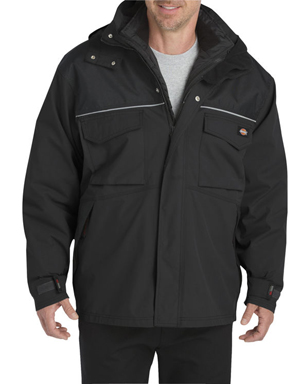 | 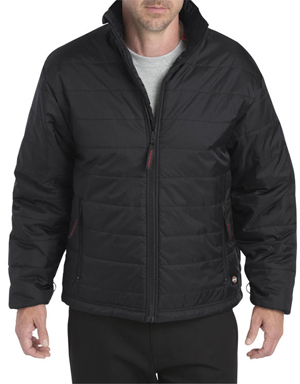 | | Pictures Copyright Dickies |
| 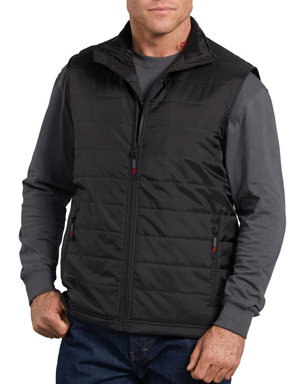 |
Made in Vietnam
DESCRIPTION AND INITIAL IMPRESSIONS
Dickies advertised its Pro (trademarked) integrated outerwear system as customized outerwear for extreme weather conditions. The "Pro" is built on the Jasper Extreme Coat, an outer shell. The Jasper Extreme Coat can be worn separately or zipped together with the Glacier Extreme Puffer or Frost Extreme Fleece. The Glacier Puffer Vest also will zip-in as a part of the Pro integrated outerwear system.
The Jasper Extreme Coat is made with 100% nylon. It is laminated with 10K/10K 100% polyester reinforcement and features a 70 gsm (grams per square meter), 100% polyester mesh lining so as to be waterproof and breathable.
"10K/10K"? "70 gsm"? What is that all about?
Since the above specs were meaningless to me, I had to do a bit of research to find out that the higher the gsm, the heavier the fabric. At 70 gsm, the lining of the Jasper Extreme Coat is very lightweight. As for the "10K/10K" stuff; the first "10K" is a measurement of how waterproof the fabric is. In this case, a 10k or 10,000 mm fabric, taking a square tube with the inner dimensions of 1" x 1" (2.5 x 2.5 cm) over a piece of the fabric, it could be filled with water to a height of (the second "10K") 10,000 mm (32.8 feet) before water would begin to leak through.
Add to that, the waterproof pit zips and sealed and triple needle reinforced seams, it sounds like this coat is meant to definitely be waterproof and breathable!
The Jasper Extreme Coat is made for a man and it fits that way. It has an adjustable hood which is also removable. The cuffs can be adjusted as well. The interior fleece collar has a chafe resistant neck guard.
The Dickies Pro Glacier Extreme Puffer is constructed of 100% taffeta with DWR (durable water repellent) properties. It is lined with Thinsulate insulation which is a non-bulky insulation. It has the ability to zip into the Dickies Pro Jasper Extreme Coat.
The hem is adjustable via a bungee and the exterior cuffs feature a "locker and loop" elastic binding for a customized fit. There are interior and lower outer pockets with zipper closures and a media port inside as well.
The interior fleece collar is a nice touch for added protection without a scratchy neckline.
Rather than go with the Glacier Extreme Fleece, I got the Dickies Pro Glacier Extreme Puffer Vest. It too is made with 100% taffeta and Thinsulate insulation with an interior fleece collar adjustable bungee hem and elastic cuff binding and features PU (polyurethane) coating and DWR technology. It sports exterior lower pockets with zipper closures as well as interior pockets with zipper closures and a media port.
It has the ability to zip into the Dickies Pro Jasper Extreme Coat.
I wear a size 43 jacket (a US LARGE) and have a 30 in (76 cm) arm length and a 16.6 in (42.2 cm) neck and I am 5 ft 7 inches (170 cm) tall.
Just looking at it, my first impression was that this coat would be very heavy. But it's not very heavy. It's medium heavy. It looks like it made of a black canvas material, but it is, in fact, 100% nylon (see the description above).
The coat sleeves are just a slight bit long, but I can easily use the hook and loop tie-backs at each cuff to hold the sleeve from slipping over my wrist. The coat ends up just at the bottom of my rear end, which is the way I like a shell.
When zipped up with either the puffer or vest as a liner, there is plenty of room to move my arms around and be comfortable. The large size MAY be slightly bulky on me, but I'd rather have it a little more roomy than be tight-fitting. I'll know more after extended use under different conditions.
The detachable lined hood is sturdily attached with four very sturdy snaps and it can be easily folded and stored in one of the side pockets with room for a few other items as well.
The Puffer is an attractive puff design and it zips into the coat. It is certainly attractive enough to be worn by itself.
The sleeves are just short enough so they don't extend outside the coat sleeve and will work fine for me when worn separately. The vertically zipped right and left inside pockets are fleece lined and support media devices and extra eye glasses, or whatever will fit.
The vest is also attractive and zips easily into the coat instead of the Fleece Liner. It has a nice high fleece lined collar and the same pocket arrangement as the Puffer.
This is quite a set. Each piece can stand alone and the coat can be use with the Puffer or the Vest, or both without zipping in the Vest (which I have not tried yet, but will - with pictures) for extreme cold.
READING THE INSTRUCTIONS
Care instructions for the Dickies Jasper Extreme Coat are printed on an interior cloth tag sewn into the side seam of the jacket. The instructions are in three languages - English, French and Spanish as well as in the usual international care symbols.
They are as follows: machine wash in cold water with like colors using only a non-chlorine bleach (if needed), and no fabric softeners or dryer sheets. Tumble dry on low, removing promptly and using a medium iron if needed.
For the Jasper Extreme Puffer and the Vest, the care instructions are the same EXCEPT, NO IRONING. And there is an additional warning label advising that the Puffer should not be worn where there is a danger of ignition.
SUMMARY
I just received these a few days ago and I already have been using the vest as a solo piece because it looks just great and I really like wearing vests. It's been quite comfortable to work and drive in and I'll report more detail on various uses as part of this report.
So, more later as we progress through this 16 week report process. We are going into our winter season here in Colorado although it's still going to be 50 F (10 C) and sunny this week. It appears that it could be very useful in the mountains at high altitudes as temperatures drop into negative figures, especially if one has to work for long hours in the field. I am really looking forward to doing this report.
FIELD REPORT
FIELD LOCATIONS AND PERFORMANCE
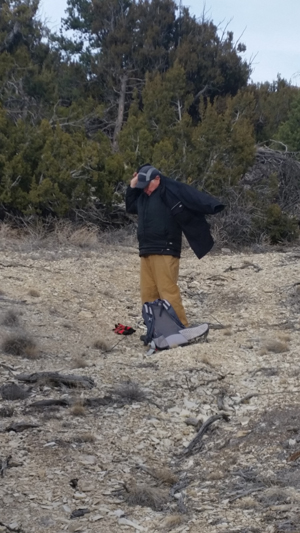 | I've had the opportunity to try this product out in many different ways over the past several weeks. It is very versatile because there are 7 different combinations of the 3 pieces that make up the set. So, it was fun to try them all.
I've become a big fan of wearing just the vest if the temperature is above 20F (-6.7C) and below 75F (23.9C). It looks great and is warm and breathes well.
The Jacket is well made and not TOO heavy to wear, but will not compress well to take along inside my backpack. So, I have had to attach it to the outside for testing along the trail. I add this below 20F (-6.7C) and when the wind is blowing above 15Mph (24.1Kph) when the temperature is below 30F (-1.1C) or so.
The shell is quite well made and is also not TOO heavy compared to other shells I have tested, but like the jacket, will not compress well to stuff into even a 65 Liter backpack. So, it also needs to be carried outside my pack. I like to wear this when the temperature is below 40F (4.4C) and it is raining or snowing or blowing above 20Mph (32.2Kph). I carried the hood in the hood pouch to use when snowing or raining heavily and it worked very well.
Because there were 7 combinations, I had a little difficulty keeping good notes about what I was wearing and switching to from time to time on the same trek.4342564974755617
On the Tanner Trail south of Canon City, Colorado, when the temperature was 46F (7.8C) and the wind was blowing at about 8Mph (12.9Kph), all I needed was the vest for an 8mile (12.9 Km) hike at 5,400 ft (1.65 Km) to 6,800 ft (2.2Km). It was sunny and clear, so I didn't even bother to bring the shell, but I did bring the jacket. I am very satisfied about how comfortable this vest is. Because it is longer than other sport-type vests I have used, it stays in place and is below the backpack waist belt so it doesn't move around. I didn't need the jacket on this trip. |
We didn't have a lot of snow in Fremont County, Colorado, during the past several weeks. We finally did get a snow and ice storm that blanketed the area for a few days and I was fortunate enough to have to hike up along a trail during a snow squall. The temperature was 25F (3.9C), wind was blowing at about 10Mph (16.1Kph), gusting to about 15Mph (24.1Kph) and it was snowing pretty hard. This was at about 5,740 ft (1.7Km). I was wearing a lower base layer, heavy waterproofed pants and 2 upper base layers with the Dickies vest, the Dickies Jacket and the Dickies shell with its hood attached and in place. The shell repelled the snow very well. It didn't get soaking wet and it served great as a wind shell as well. I was warm and comfortable.
I the hood was difficult to remove from the hood pouch and attach to the shell when wearing the shell though. I had trouble finding the correct snaps by feel and had to make multiple attempts to align the snaps correctly. Then I had a problem getting the front snaps to come together under my chin without choking myself. So, I didn't connect the snaps together under my chin on this trip, but really didn't need to. I was well protected and felt just fine. The hood can come up over my chin, and if I wanted to, I could have had it cover my mouth as well.
A few weeks later, we decided to hike several miles along the Oil Well Flats trails up by Cooper Mountain in Fremont County. These trails average about 5,900 ft (1.8Km) and have beautiful views. It started to rain and then the rain started turning to ice crystals. I started out with the vest and the jacket combo because it was 38F and starting to get colder. I had the shell with me and tossed that on over the vest/jacket combo when the precipitation started. I was impressed at how the shell repelled the ice. I took 2 pictures that show the ice on my sleeve and how it just brushed right off. The shell did not retain any water and it was snowing and icing for an hour or so.
Of course, like I do with a lot of my gear, I still use it when working outdoors on my network microwave towers. So aside from trail use, I have worn this set a lot while working in the field. It is tough. I have put tools and lag bolts in the pockets, and everything held up just great. I have seen no signs of wear and tear at all anywhere on the product.
There is plenty of roominess also. These Large size pieces I have fit comfortably for me. Even with the jacket over the vest and the shell on over those two pieces, the 3 pieces don't feel tight at all for me. I normally wear a large sweatshirt or jacket.
SUMMARY
I've always thought of Dickies as a work clothing company. With this product they are reaching for the outdoor enthusiast and they did pretty well on this venture in that direction.
We are headed into more winter weather starting this week. I'm look forward to trying these out in more serious winter weather.
LONG-TERM REPORT
LONG-TERM TEST LOCATIONS AND CONDITIONS
Well, I extended this field report in an effort to find more snow and colder weather. We tried going to 11,000 feet (3.4 km) above sea level at Winter Park, Colorado, only to find that the snow was above 13,000 ft. (4 km) and the trails were difficult to find. Same at Rocky Mountain National Park, but we did hike 6 miles (9.7 km) along Trail Ridge Road where the snow pack was neck high.
PERFORMANCE IN THE FIELD
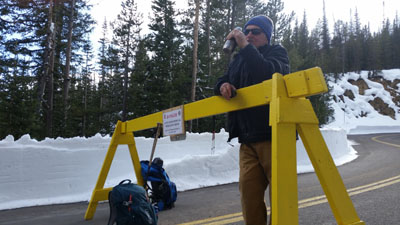 | | Taking a break on Trail Ridge Road in RMNP Naitona |
| In rain and snow, this combo is just great. The 3-piece set can be organized for any weather coming my way.
The vest is attractive and slim-fitting and keeps my core warm. Not as warm as a puffy down vest, but warm enough without looking overweight. Plus, it fits under the jacket and under the shell very nicely.
This vest has become my "go to" article of outerwear since it is so versatile. I have other heavy winter shells that have zip in liners, but there is something I like about looking good in the layers when wearing them separately.
When combined, the set is kinda bulky, as to be expected from a work clothing set. I found that wearing all 3 pieces can get quite warm and I have unzipped pretty quickly to avoid overheating and sweating as we hike along. This is an outfit I will use first when we have to hike in sub-zero weather (along with my thermal leggings).
The outfit is well equipped with pockets, as described earlier. So when wearing all 3 pieces, I needed to remember where I put things.
The shell dries pretty fast. I had gotten it soaked last week in a cold, wet snow, and I just hung it up to dry and it was fine in an hour. Of course, our humidity here is 20% to 40% usually. I had the vest and the jacket on under the shell, and they were damp from condensation and dried in 10 minutes and I did not feel damp wearing the combo. |
SUMMARY
I like this set because now I have a heavy-duty combination to wear in extreme weather AND I have an attractive vest to use in cool weather and a jacket to wear between extreme and cool weather. This set covers a wide range of conditions and uses.
My Conclusions:
Fit & Comfort: Excellent
Durability: Excellent
Water Resistance: Very Good
Breathability: Fair
Pack Size: Needs lots of room.
Wear Weight: Vest is fine. Jacket is fine. Shell is heavy. All 3 together are great for cold weather.
Color: No fade after washing and normal use.
Care: Machine washed fine. Mud cleaned off with wet towel.
Appearance: Vest and jacket look great. Shell looks like a heavy-duty shell.
Overall Opinion: Excellent Multi-use outerwear
Thank you to BackpackGearTest.org and Dickies for the chance to stay warm and dry this winter season on the trails in the Pro Jasper Extreme Coat, Glacier Puffer Jacket and Vest.
John R. Waters
This report was created with the BackpackGearTest.org Report Writer Version 1.5
Copyright 2019. All rights reserved.
Read more reviews of Williamson-Dickie gear
Read more gear reviews by John Waters
|




